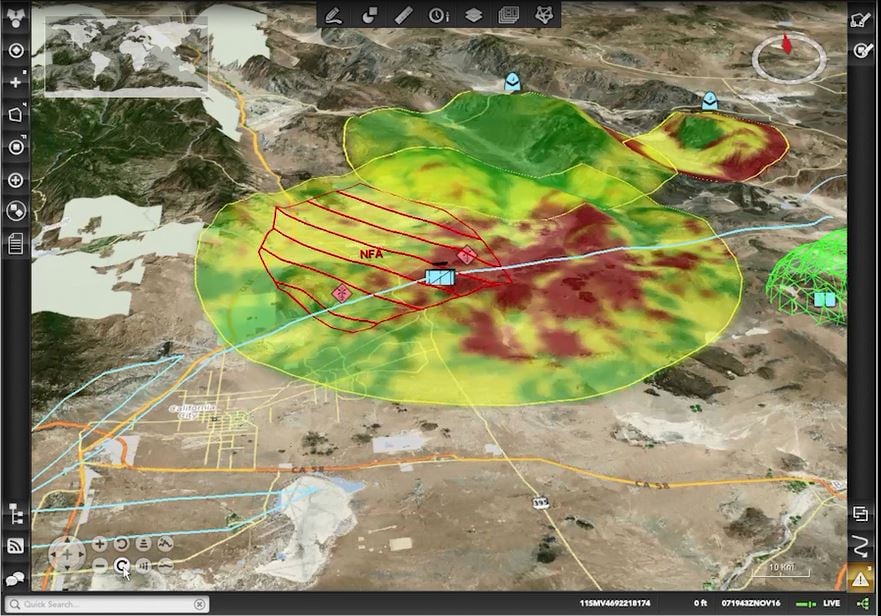The Army is looking for the most modern commercial capabilities to complement its Electronic Warfare Planning and Management Tool.
In a June 5 solicitation, the Army said it is looking to "identify industry sources capable of providing a range of services and efforts necessary to continue the design, build, integration, testing, delivery, and maintenance of the Electronic Warfare Planning and Management Tool (EWPMT) system."
EWPMT is a command-and-control planning capability that allows commanders and soldiers to visualize and thus plan out what electronic warfare effects will look like in the field if employed via a graphical user interface.
The program consists of four increments or capability drops. The first capability drop was fielded to Fort Bliss, Texas, in September and provides a visual of what can be jammed; what is being jammed; what is emitting; what the enemy emitter looks like; what it might look like to plan around the enemy’s emitting capability; and a strategy for jamming the enemy to allow for physical maneuver in the terrain. The other three capability drops are related to spectrum management and cyber situational awareness through a follow-on capability called Cyber and Electromagnetic Battle Management that will give commanders more options — exploiting cyber vulnerabilities of sensors in the field as opposed to jamming — from which to choose.
"This RFI was issued in an effort to ensure the Electronic Warfare Planning Management Tool Increment 1 program has an updated understanding of the current capabilities available in the marketplace. It is not tied to a particular capability drop," Lt. Col. Marc Dorrer, of Product Manager Electronic Warfare Integration, said in an emailed statement to C4ISRNET.
An Army spokesman noted this is not a renegotiation, but merely a mechanism required by the Federal Acquisition Regulation for market research every 18 months.
Raytheon is currently working capability drop one and two.
According to Army budget documents released in late May, initial operational capability of EWMPT is scheduled for the first quarter of 2017, with the development test of the second capability drop beginning in the fourth quarter of 2016, a limited user test of capability drop two in the second quarter of 2018 and a limited deployment decision of capability drop two in the fourth quarter of 2018.
The Army's $5.8 million fiscal 2018 base procurement will support continuous EWMPT fielding, new equipment training, delta training, interim contractor support and program management. Additionally, the FY18 budget funds $33.12 million to complete capability drop two's development, test and support activities and begin initial development of capability drop three.
The development and testing of capability drop three is slated to begin in the third quarter of 2018, ending in the first quarter of 2020, with the development and testing of capability drop four slated to begin in the fourth quarter of 2019 and ending in the fourth quarter of 2021.
"EWPMT is an Automated Information System (AIS) that will follow an evolutionary acquisition strategy using an Incrementally Deployed Software Intensive Program for rapid development and continuous product improvements," the budget documents state. "The overall strategy is to deploy software Capability Drops (CDs) to allow an incremental merger of the Electronic Warfare and Spectrum Management software tools."
The Army’s notice calls for 10 requirements:
1)
Create/import/export/modify force structure information, radio frequency emitter data/characteristics, and frequency assignment and power to/from electromagnetic spectrum operations tool sets for modeling and simulations against planned electronic attack operations.
2)
Provide modeling and simulation of EW effects.
3)
Integrate electronic intelligence and communications intelligence data from joint and national repositories.
4) Ability to illustrate the impact of cyber and electromagnetic activity on proposed courses of action, compare multiple courses of action and display radio frequency propagation effects of electronic attack on the intended target and any adverse or unintended effects on surrounding friendly equipment or facilities.
5)
Provide the ability to determine sources of interference and display spectrum situational awareness.
6)
Display current and post-mission analysis to determine mission effectiveness and enemy battle damage assessment.
7)
Display EW strike and detected radio frequency emitters associated with enemy weapons and sensor systems providing display warning of impending threat or attack.
8)
Provide find, fix and target information to fires and maneuver elements based on multifunction EW survey data to support the deliberate targeting process for scheduled and on-call targets.
9)
Support the nomination of prioritized targets for lethal and nonlethal effects.
10)
Provide find, fix and target information to fires and maneuver elements involving actions tasked by, or under direct control of an operational commander to search for, intercept, identify and locate sources of intentional and unintentional radiated electromagnetic energy for the purpose of immediate threat recognition, targeting, planning and conducting future operations.
Mark Pomerleau is a reporter for C4ISRNET, covering information warfare and cyberspace.








